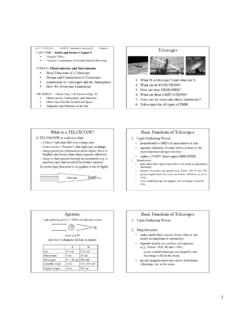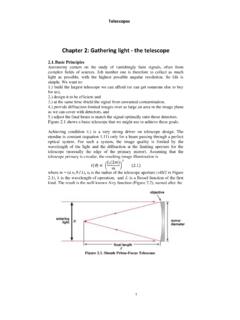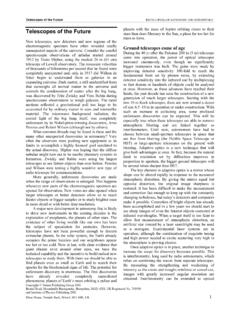Transcription of Building a Telescope - NASA
1 53 Optics: An Educator s Guide With Activities in Science and Mathematics EG-2000-10-64-MSFCL evel: Grades (9 12)Activity: 15 Building a TelescopeTheoryABObjectiveScience and Mathematics StandardsMaterialsIn a Telescope , the lens held nextto your eye is called the eyepiece andis usually a short focal length lens ora combination of lenses. The lens atthe other end of the Telescope iscalled the objective lens. Light froma distant object is focused by theobjective lens to form an image infront of the eyepiece. The eyepieceacts as a magnifier and enlarges thatimage. The magnification of thetelescope can be found by dividingthe focal length of the objective bythe focal length of the eyepiece. 2 converging lenses (convex lenses) telescoping tubes (mailing tubes) manila file folder scissors knife or saw glue 1 white poster board red and black tapeThe student will construct a simplerefracting Telescope and calculate Standards Science as Inquiry Physical ScienceMathematics Standards Problem Solving Communication Connection Computation/Estimation MeasurementLenses, Refraction54 Light, Color, and Their UsesOptics.
2 An Educator s Guide With Activities in Science and Mathematics EG-2000-10-64-MSFCABCDP roceduresThis Telescope will be constructedusing the same lenses that were usedin the experiment named, FocusingLight With a Lens, page The mailing tubes will be the bodyof the Telescope with the smallerone sliding inside the larger length of the assembledtelescope will be a little longer thanthe sum of the focal lengths of thetwo lenses. Add the value of thefocal lengths of the short and longlens together. Divide that length bytwo and then add another inch. Cutboth of the tubes to that length witha knife or Use the scissors to cut out two circlesfrom the manila paper that are thesame size as the diameter of themailing tube. These circle frameswill mount and center the lenses onthe tube. With a knife, cut out circlesthat are slightly smaller than thediameter of the lenses in the centerof the paper frame circle.
3 Glue thelenses to the center of the frame. Theshorter focal length lens will be theeyepiece. Glue that framed lens tothe end of the smaller tube. Glue theother framed lens to the end of thelarger Slide the two cardboard tubestogether. You have now assembleda simple refracting Telescope . Lookthrough the eyepiece of yourtelescope and focus it on a distantobject. Slide the two cardboardtubes in and out until you have aclear image. What do you observe?4. Use the red and black tape to makestripes on the white posterboard(see illustration on page 55) to useas a tubeLens with shortestfocal length(eyepiece)Manila frameLens with longest focal length(objective lens)Manila frame55 Optics: An Educator s Guide With Activities in Science and Mathematics EG-2000-10-64-MSFCB lackTapeRedTapePoster Board2. Evaluate your calculatedmagnification.
4 Stand at one end ofthe room and look at the chart withred and white stripes, and blackand white stripes. Look directlyat the chart with one eye and lookthrough the Telescope with the othereye. This may be a little difficult atfirst, but with a little practice youwill find that you can do How much is the chart magnified?Observations, Data, and Conclusions1. To compute the power ormagnification (M) of your Telescope ,you will use the focal lengthscomputed in the experimentnamed, Focusing Light With aLens, page 49. Insert the numberfor each previously computed focallength into the following equation:M = power or magnificationFe = focal length of the eyepieceFo = focal length of the objective FoM= FeThe magnification of my Telescope is4. Do you think the amount ofmagnification observed throughyour Telescope matched themagnification you computed foryour Telescope ?
5 5. In observing objects through yourtelescope, did the image appearclear?6. How was the observed imageoriented?Comment: The useful magnificationof a Telescope is limited by diffraction limit is about 10 timesmagnification per inch of diameter ofthe objective : an objective lens 2 inches indiameter will provide a realistictelescope power of 20 , Refraction56 Light, Color, and Their UsesOptics: An Educator s Guide With Activities in Science and Mathematics EG-2000-10-64-MSFCC onverging lenses can be found inmany of the everyday items we see inour homes. How many can you find?Here are a few examples: Paperweights,fish bowls with water in them, bottomsof soda bottles, Home ScientistDiagonal MirrorEyepieceParabolic MirrorNewtonian Reflector TelescopeLensLensEyepieceObjective LensRefractor TelescopeMost astronomical telescopes arereflectors.
6 Objective mirrors are easierto make than objective lenses. Largemirrors are structurally easier todesign and less expensive to buildthan large lenses.



















